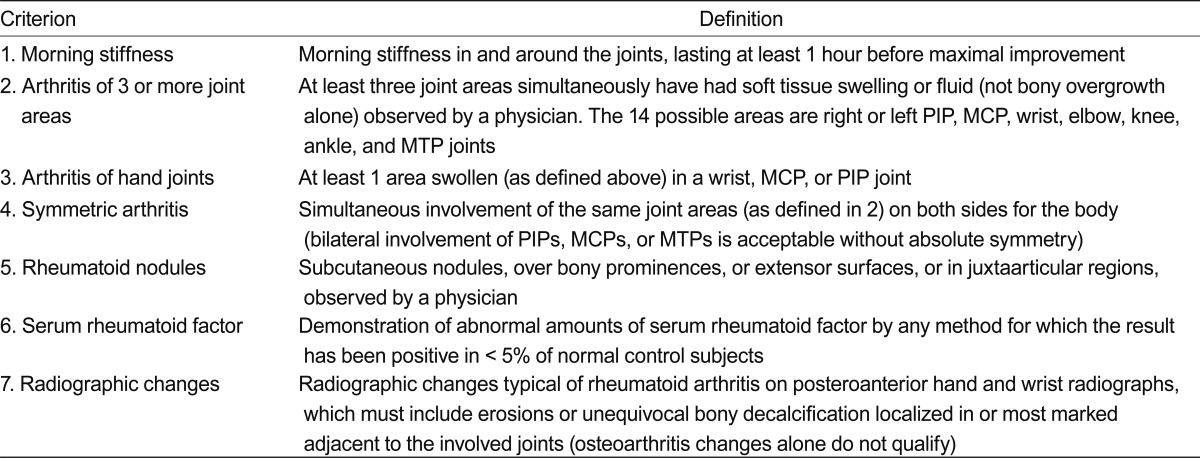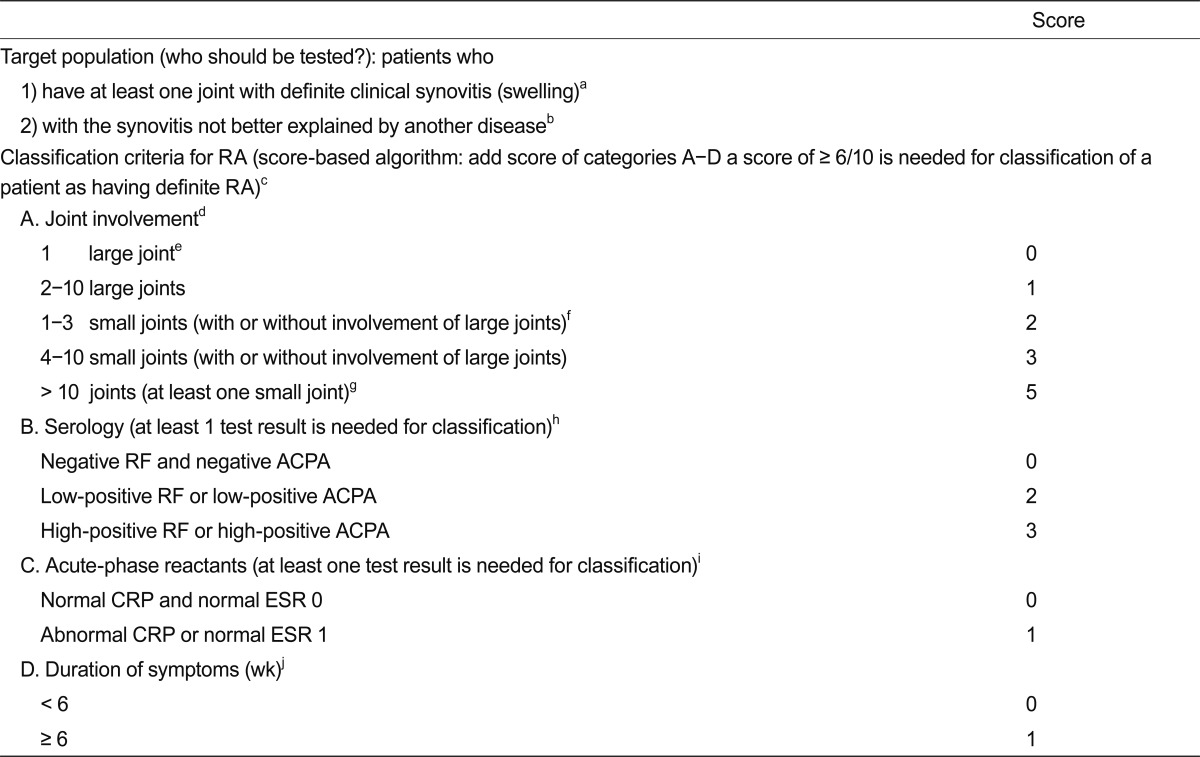3. Szekanecz Z, Pakozdi A, Szentpetery A, Besenyei T, Koch AE. Chemokines and angiogenesis in rheumatoid arthritis. Front Biosci (Elite Ed) 2009;1:44ŌĆō51PMID : 19482623.


4. Polzer K, Baeten D, Soleiman A, et al. Tumour necrosis factor blockade increases lymphangiogenesis in murine and human arthritic joints. Ann Rheum Dis 2008;67:1610ŌĆō1616PMID : 18174217.


6. Miossec P, Korn T, Kuchroo VK. Interleukin-17 and type 17 helper T cells. N Engl J Med 2009;361:888ŌĆō898PMID : 19710487.


9. Schwartz RH. Costimulation of T lymphocytes: the role of CD28, CTLA-4, and B7/BB1 in interleukin-2 production and immunotherapy. Cell 1992;71:1065ŌĆō1068PMID : 1335362.


10. Genovese MC, Schiff M, Luggen M, et al. Efficacy and safety of the selective co-stimulation modulator abatacept following 2 years of treatment in patients with rheumatoid arthritis and an inadequate response to anti-tumour necrosis factor therapy. Ann Rheum Dis 2008;67:547ŌĆō554PMID : 17921185.


11. Edwards JC, Szczepanski L, Szechinski J, et al. Efficacy of B-cell-targeted therapy with rituximab in patients with rheumatoid arthritis. N Engl J Med 2004;350:2572ŌĆō2581PMID : 15201414.


12. Feldmann M, Brennan FM, Maini RN. Rheumatoid arthritis. Cell 1996;85:307ŌĆō310PMID : 8616886.


13. Hirano T, Yasukawa K, Harada H, et al. Complementary DNA for a novel human interleukin (BSF-2) that induces B lymphocytes to produce immunoglobulin. Nature 1986;324:73ŌĆō76PMID : 3491322.


17. Kirkham BW, Lassere MN, Edmonds JP, et al. Synovial membrane cytokine expression is predictive of joint damage progression in rheumatoid arthritis: a two-year prospective study (the DAMAGE study cohort). Arthritis Rheum 2006;54:1122ŌĆō1131PMID : 16572447.


18. Hueber W, Patel DD, Dryja T, et al. Effects of AIN457, a fully human antibody to interleukin-17A, on psoriasis, rheumatoid arthritis, and uveitis. Sci Transl Med 2010;2:52ra72.

19. Bradfield PF, Amft N, Vernon-Wilson E, et al. Rheumatoid fibroblast-like synoviocytes overexpress the chemokine stromal cell-derived factor 1 (CXCL12), which supports distinct patterns and rates of CD4+ and CD8+ T cell migration within synovial tissue. Arthritis Rheum 2003;48:2472ŌĆō2482PMID : 13130466.


21. Visser H, le Cessie S, Vos K, Breedveld FC, Hazes JM. How to diagnose rheumatoid arthritis early: a prediction model for persistent (erosive) arthritis. Arthritis Rheum 2002;46:357ŌĆō365PMID : 11840437.


22. Gravallese EM, Harada Y, Wang JT, Gorn AH, Thornhill TS, Goldring SR. Identification of cell types responsible for bone resorption in rheumatoid arthritis and juvenile rheumatoid arthritis. Am J Pathol 1998;152:943ŌĆō951PMID : 9546355.


23. McInnes IB, Schett G. The pathogenesis of rheumatoid arthritis. N Engl J Med 2011;365:2205ŌĆō2219PMID : 22150039.


24. Simsek I. TNF inhibitors: new and old agents for rheumatoid arthritis. Bull NYU Hosp Jt Dis 2010;68:204ŌĆō210PMID : 20969553.

25. Ohta S, Tsuru T, Terao K, et al. Optimal dose prediction by pharmacokinetic and biomarker response of subcutaneous tocilizumab treatment: a phase I/II study evaluating the safety, pharmacokinetics and clinical response in patients with rheumatoid arthritis. Arthritis Rheum 2010;62(Suppl 10):S1115.
27. Buch MH, Emery P. New therapies in the management of rheumatoid arthritis. Curr Opin Rheumatol 2011;23:245ŌĆō251PMID : 21427579.


28. Genovese MC, Durez P, Richards H, Hugot S, Thangavelu K, Mpofu S. Secukinumab (AIN457), a novel monoclonal antibody targeting IL-17A demonstrates efficacy in active rheumatoid arthritis patients despite stable methotrexate treatment: results of a phase IIb study [abstract]. Arthritis Rheum 2010;62:L9.

29. Kremer JM, Bloom BJ, Breedveld FC, et al. The safety and efficacy of a JAK inhibitor in patients with active rheumatoid arthritis: results of a double-blind, placebo-controlled phase IIa trial of three dosage levels of CP-690,550 versus placebo. Arthritis Rheum 2009;60:1895ŌĆō1905PMID : 19565475.


30. Tanaka Y, Suzuki M, Nakamura H, Toyoizumi S, Zwillich SH. Tofacitinib Study Investigators. Phase II study of tofacitinib (CP-690,550) combined with methotrexate in patients with rheumatoid arthritis and an inadequate response to methotrexate. Arthritis Care Res (Hoboken) 2011;63:1150ŌĆō1158PMID : 21584942.


32. Weinblatt ME, Kavanaugh A, Genovese MC, Musser TK, Grossbard EB, Magilavy DB. An oral spleen tyrosine kinase (Syk) inhibitor for rheumatoid arthritis. N Engl J Med 2010;363:1303ŌĆō1312PMID : 20879879.


33. Arnett FC, Edworthy SM, Bloch DA, et al. The American Rheumatism Association 1987 revised criteria for the classification of rheumatoid arthritis. Arthritis Rheum 1988;31:315ŌĆō324PMID : 3358796.


34. Aletaha D, Neogi T, Silman AJ, et al. 2010 Rheumatoid arthritis classification criteria: an American College of Rheumatology/European League Against Rheumatism collaborative initiative. Ann Rheum Dis 2010;69:1580ŌĆō1588PMID : 20699241.


35. Aletaha D, Neogi T, Silman AJ, et al. 2010 Rheumatoid arthritis classification criteria: an American College of Rheumatology/European League Against Rheumatism collaborative initiative. Arthritis Rheum 2010;62:2569ŌĆō2581PMID : 20872595.


38. Salomon-Escoto KI, Gravallese EM, Kay J. Assessment of control of rheumatoid arthritis disease activity. Best Pract Res Clin Rheumatol 2011;25:497ŌĆō507PMID : 22137920.


39. Horton SC, Walsh CA, Emery P. Established rheumatoid arthritis: rationale for best practice: physicians' perspective of how to realise tight control in clinical practice. Best Pract Res Clin Rheumatol 2011;25:509ŌĆō521PMID : 22137921.


40. Smolen JS, Aletaha D. Monitoring rheumatoid arthritis. Curr Opin Rheumatol 2011;23:252ŌĆō258PMID : 21427576.


41. Felson DT, Anderson JJ, Boers M, et al. The Committee on Outcome Measures in Rheumatoid Arthritis Clinical Trials. The American College of Rheumatology preliminary core set of disease activity measures for rheumatoid arthritis clinical trials. Arthritis Rheum 1993;36:729ŌĆō740PMID : 8507213.


43. Prevoo ML, van Gestel AM, van T Hof MA, van Rijswijk MH, van de Putte LB, van Riel PL. Remission in a prospective study of patients with rheumatoid arthritis. American Rheumatism Association preliminary remission criteria in relation to the disease activity score. Br J Rheumatol 1996;35:1101ŌĆō1105PMID : 8948296.


44. Prevoo ML, van 't Hof MA, Kuper HH, van Leeuwen MA, van de Putte LB, van Riel PL. Modified disease activity scores that include twenty-eight-joint counts. Development and validation in a prospective longitudinal study of patients with rheumatoid arthritis. Arthritis Rheum 1995;38:44ŌĆō48PMID : 7818570.


45. van Tuyl LH, Britsemmer K, Wells GA, et al. Remission in early rheumatoid arthritis defined by 28 joint counts: limited consequences of residual disease activity in the forefeet on outcome. Ann Rheum Dis 2012;71:33ŌĆō37PMID : 21953347.


46. Aletaha D, Smolen J. The Simplified Disease Activity Index (SDAI) and the Clinical Disease Activity Index (CDAI): a review of their usefulness and validity in rheumatoid arthritis. Clin Exp Rheumatol 2005;23(5 Suppl 39):S100ŌĆōS108PMID : 16273793.

48. American College of Rheumatology Subcommittee on Rheumatoid Arthritis Guidelines. Guidelines for the management of rheumatoid arthritis: 2002 update. Arthritis Rheum 2002;46:328ŌĆō346PMID : 11840435.


49. Chen S, Gill MA, Luu CH, Takami S. Pain and rheumatoid arthritis: an update. Drug Topics 2000;3:47ŌĆō56.
50. Solau-Gervais E, Laxenaire N, Cortet B, Dubucquoi S, Duquesnoy B, Flipo RM. Lack of efficacy of a third tumour necrosis factor alpha antagonist after failure of a soluble receptor and a monoclonal antibody. Rheumatology (Oxford) 2006;45:1121ŌĆō1124PMID : 16510526.


51. Kim HA, Seo YI, Jung YO, et al. The rate of attaining low disease activity with Methotrexate (MTX) based non-biological DMARD in patients with rheumatoid arthritis (RA): T-2-T data from 4 university affiliated Korean rheumatology clinics. J Rheum Dis 2012;19:S142.












 PDF Links
PDF Links PubReader
PubReader ePub Link
ePub Link Full text via DOI
Full text via DOI Download Citation
Download Citation Print
Print


